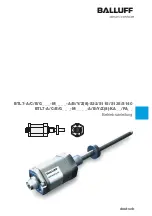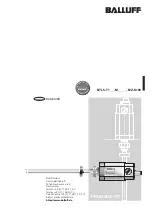
SECTION III
MAINTENANCE
3.1.
Introduction
This section provides preventive mainte-
nance information and corrective mainte-
nance procedures. The information
contained in this section is to provide guid-
ance for establishing a comprehensive
maintenance program to promote opera-
tional readiness and eliminate down time.
Particular emphasis is placed on preventive
maintenance and record-keeping functions.
For further information on maintenance of
particular board, refer to sections A through
K.
3.2.
Station Records
The importance of keeping station per-
formance records cannot be overempha-
sized. Separate logbooks should be
maintained by operation and maintenance
activities. These records can provide data
for predicting potential problem areas and
analyzing equipment malfunctions.
3.2.1.
Maintenance Logbook
The maintenance logbook should contain
a complete description of all maintenance
activities required to keep the equipment in
operational status. A listing of maintenance
information to be recorded and analyzed to
provide a data base for a failure reporting
system is as follows:
DISCREPANCY
Describe the na-
ture of the malfunction including all
observable symptoms and perform-
ance characteristics.
CORRECTIVE ACTION
Describe
the repair procedure used to correct
the malfunction.
DEFECTIVE PART(S) List all parts
and components replaced or repaired
and include the following details:
a. Time In Use
B. Part Number
C. Schematic Number
D. Assembly Number
E. Reference Designator
SYSTEM ELAPSED TIME
Total
time on equipment
NAME OF REPAIRMAN
Person
who actually made the repair
STATION ENGINEER
Indicates
Chief Engineer noted and approved
the repair of the equipment
3.3.
Preventive Maintenance
Preventive maintenance is a systematic
series of operations performed periodically
on equipment. Because these procedures
cannot be applied indiscriminately, specific
instructions are necessary. Preventive main-
tenance consists of six operations: inspect-
ing, feeling, tightening, cleaning, adjusting,
and painting.
INSPECT. Inspection is the most impor-
tant preventive maintenance operation be-
cause it determines the necessity for the
others. Become thoroughly acquainted with
normal operating conditions in order to rec-
ognize and identify abnormal conditions
readily. Inspect for the following:
Overheating, which is indicated by
discoloration, bulging of parts, and
peculiar odors.
Oxidation.
Dirt, corrosion, rust, mildew, and
fungus growth.
FEEL. Use this operation to check parts
for overheating. By this means the lack of
proper ventilation or the existence of some
defect can be detected and corrected before
serious trouble occurs. Become familiar
with operating temperatures in order to rec-
ognize deviations from the normal range.
TIGHTEN. Tighten loose screws, bolts,
and nuts. Do not tighten indiscriminately as
fittings that are tightened beyond the pres-
sure for which they are designed may be
damaged or broken.
CLEAN. Clean parts only when inspec-
tion shows that cleaning is required and
only use approved cleaning solvent.
ADJUST. Make adjustments only when
inspection shows that they are necessary to
maintain normal operation.
PAINT. Paint surfaces with the original
type of paint (using prime coat if necessary)
whenever inspection shows rust, or worn or
broken paint film.
3.3.1.
Maintenance Of Components
The following paragraphs provide infor-
mation necessary for the maintenance of
components.
TRANSISTORS. Preventive mainte-
nance of transistors is accomplished by per-
forming the following steps:
Inspect the transistors and surrounding
area for dirt as accumulations of dirt or dust
could form leakage paths.
Use compressed dry air to remove dust
from the area.
WARNING
ALWAYS WEAR SAFETY GOGGLES
WHEN USING COMPRESSED AIR.
Examine all transistors for loose connec-
tions or corrosion. Tighten the transistor
mounting hardware to no more than 5 inch-
pounds. Over-tightening the transistor
hardware will cause the silicon insulators to
curl up on the ends and possibly short
through. When replacing a MOSFET tran-
sistor, be sure to alternate frequently be-
tween the mounting posts to tighten the
hardware down evenly. This will minimize
the possibility of shorting through an insu-
lator.
CAUTION
IF THE TRANSISTORS IN THE PA OR IPA
REQUIRE CHANGING, ENSURE THAT ALL
OF THE TRANSISTORS ARE OF THE SAME
TYPE NUMBER AND ARE FROM THE SAME
MANUFACTURER.
INTEGRATED CIRCUITS. Preventive
maintenance of integrated circuits is ac-
complished by performing the following
steps:
CAUTION
USE CARE TO AVOID THE BUILDUP OF
STATIC ELECTRICITY WHEN WORKING
AROUND INTEGRATED CIRCUITS.
Inspect the integrated circuits and sur-
rounding area for dirt as accumulations of
dirt or dust could form leakage paths.
Use compressed dry air to remove dust
from the area.
WARNING
ALWAYS WEAR SAFETY GOGGLES
WHEN USING COMPRESSED AIR.
CAPACITORS. Preventive maintenance
of capacitors is accomplished by perform-
ing the following steps:
Examine all capacitor terminals for
loose connections or corrosion.
Ensure that component mountings are
tight. (Do not over tighten capacitor
mounting straps as excessive pressure
could cause internal shorting of the
capacitors.
Examine the body of each capacitor
for swelling, discoloration, or other
evidence of breakdown.
Use standard practices to repair poor
solder connections with a low-watt-
age soldering iron.
Clean cases and bodies of all capaci-
tors.
Inspect the bleeder resistors when inspect-
ing the electrolytic capacitors.
FIXED RESISTORS. Preventive main-
tenance of fixed resistors is accomplished
by performing the following steps:
When inspecting a chassis, printed-
circuit board, or discrete component
Rev. AD
888-2314-001
3-1
WARNING: Disconnect primary power prior to servicing.
Содержание Gates Five 994 9204 002
Страница 4: ......
Страница 6: ...iv 888 2314 001 Rev X WARNING Disconnect primary power prior to servicing...
Страница 8: ...vi 888 2314 001 Rev X WARNING Disconnect primary power prior to servicing...
Страница 28: ...2 12 888 2314 001 Rev AC 2 29 00 WARNING Disconnect primary power prior to servicing...
Страница 40: ...Figure 5 1 PDM Flow Diagram 5 2 888 2314 001 Rev T Jan 1996 WARNING Disconnect primary power prior to servicing...
Страница 42: ...Figure 5 2 PDM Loop 5 4 888 2314 001 Rev T Jan 1996 WARNING Disconnect primary power prior to servicing...
Страница 43: ...Figure 5 3 RF Flow Rev T Jan 1996 888 2314 001 5 5 WARNING Disconnect primary power prior to servicing...
Страница 76: ...C 6 888 2314 001 Rev AE 03 05 2002 WARNING Disconnect primary power prior to servicing...
Страница 82: ...E 4 888 2314 001 Rev AE 03 05 2002 WARNING Disconnect primary power prior to servicing...
Страница 88: ...F 6 888 2314 001 Rev AE 03 05 2002 WARNING Disconnect primary power prior to servicing...
Страница 96: ...H 2 888 2314 001 Rev AA 8 18 1999 WARNING Disconnect primary power prior to servicing...
Страница 104: ...K 2 888 2314 001 Rev AE 03 05 2002 WARNING Disconnect primary power prior to servicing...
Страница 105: ...Figure K 1 Interface Board Rev AE 03 05 2002 888 2314 001 K 3 WARNING Disconnect primary power prior to servicing...
Страница 108: ...L 2 888 2314 001 WARNING Disconnect primary power prior to servicing...
















































